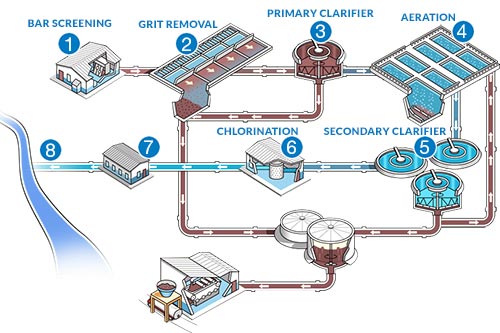Some Known Details About Uv Water Purification System
Table of Contents5 Easy Facts About Uv Water Purification System DescribedRumored Buzz on Uv Water Purification SystemHow Uv Water Purification System can Save You Time, Stress, and Money.Some Of Uv Water Purification SystemGet This Report about Uv Water Purification SystemTop Guidelines Of Uv Water Purification System
1 The need for massive water therapy, Water treatment is the procedure of eliminating all those compounds, whether biological, chemical or physical, that are potentially hazardous in water supply for human and also domestic usage. Water likewise needs to be non-corrosive, suggesting it will not cause damages to pipework.This produces a demand for big quantities of risk-free water to be provided dependably and constantly, and this need is growing - uv water purification system. As metropolitan populaces raise, there is a requirement to find new resources to fulfill the expanding need. If groundwater is offered this can frequently be used with marginal treatment but any kind of surface area water resource will require to be dealt with to make it safe.
6 describes how this estimation is made yet first you will look at the primary phases in the water therapy process. 2) in large water treatment for urban community water supply (Abayneh, 2004).
Getting My Uv Water Purification System To Work
(There is a chlorination step at the end of the treatment procedure, which is normal in many water treatment plants). The pre-chlorination also oxidises taste- and also odour-causing compounds. 5.2. 3 Coagulation and flocculation, After oygenation, coagulation occurs, to eliminate the great bits (much less than 1 m in size) that are suspended in the water.
Below the water is gently stirred by paddles in a flocculation basin (Number 5. 5) and the flocs enter into contact with each other to develop larger flocs. The flocculation container often has a variety of compartments with reducing mixing rates as the water advances through the container (Figure 5.
6(b)) for a number of hours for sedimentation to take area. The product accumulated at the end of the storage tank is called sludge; this is eliminated for disposal. 5.2. 5 Filtration, Filtering is the procedure where solids are separated from a fluid. In water therapy, the solids that are not divided out in the sedimentation tank are removed by passing the water with beds of sand and also gravel.
The Main Principles Of Uv Water Purification System
7), with a flow rate of 48 cubic metres per square metre of filter surface area per hr (this is composed as 48 m3 m2 h1) are often made use of. When the filters are full of entraped solids, they are backwashed. In this procedure, tidy water as well as air are pumped in reverse up the filter to remove the entraped pollutants, as well find out here now as the water lugging the dust (described as backwash) is pumped into the sewage system, if there is one.
6 Chlorination, After sedimentation, the water is decontaminated to get rid of any type of continuing to be pathogenic micro-organisms. The you can try this out most frequently used disinfectant (the chemical used for disinfection) is chlorine, in the form of a liquid (such as sodium hypochlorite, Na, OCl) or a gas.
The quantity of chlorine left hereafter is called residual chlorine. This remains in the water right with the distribution system, protecting it from any kind of micro-organisms that may enter it, until the water reaches the customers. World Health Company Guidelines (WHO, 2003) suggest a maximum recurring chlorine of 5 mg l1 of water (uv water purification system).
Uv Water Purification System Things To Know Before You Buy
5 mg l1 of water after 30 mins' contact time (THAT, n. d.). There are various other ways of sanitizing water (e. g. by making use of the gas ozone, or ultraviolet radiation) but these do not secure it from microbial contamination after it has actually left the water treatment plant. Complying with sanitation the treated water is pumped into the distribution system.
7 Supplementary treatment, Supplemental treatment might sometimes be needed for the benefit of the populace. One such instance is the fluoridation of water, where fluoride is added to water. It has been specified by the Globe Health Company that 'fluoridation of water supplies, where possible, is the most efficient public health and wellness action for the prevention of dental decay' (WHO, 2001).

The Single Strategy To Use For Uv Water Purification System
5 mg l1. What does excess fluoride in the water bring about? As pointed out in Study Session 2, in youngsters it can trigger mottling of teeth as well as prolonged direct exposure can create skeletal fluorosis as well as crippling. In such high-fluoride areas, elimination or reduction of fluoride (labelled defluoridation) is necessary. The easiest means of doing this is to blend the high-fluoride water with water that has no (or really little) fluoride so that the final mixture is secure.
Both chemicals are included to and quickly combined with the fluoride-contaminated water as well as after that the water is mixed gently. Flocs of aluminium hydroxide type and also these remove the fluoride by adsorption as well as ion exchange. The flocs are after that removed by sedimentation. 5.3 Administration of wastes from water therapy plants, From the water therapy process that you have simply researched, make a list of the different wastes that develop.
In the latter it is contributed to the incoming sewage, where it can assist settlement of solids. The backwash from the sand filter is discharged into the drain or returned to the river after settlement of solids. Product packaging waste such as chemical drums can be returned to the vendor for reuse (uv water purification system).
Excitement About Uv Water Purification System
